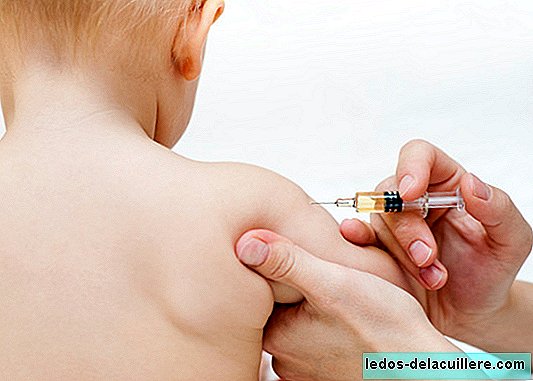It is very likely that when reading the headline you think the same as 99% of people to whom I have explained these days that the new meningitis vaccine is already in the pharmacy, by name "Nimenrix": That? How? Other? And the Bexsero?
Well, that. La Bexsero, which protects against infection by meningitis B It is still in a situation similar to that of the last months: you have to talk to the pediatrician, who will prescribe it or not, and in that case ask for it at the pharmacy and wait for it to arrive.
Anyway, the personal feeling I have is that the waters are much more relaxed lately in this regard, and it is that we have not heard of any cases of meningitis B in the country for a long time, and that is why parents are a little less alarmed for not being able to get a vaccine that protects from a very serious but rare disease (If you want to know more about Bexsero, you can read this entry in which we made a summary of the most important).
The new 'Nimenrix' vaccine
And now, still waiting for them to arrive, it turns out that a new vaccine appears to protect children against meningitis. Other? And those who have paid and managed the Bexsero? Y… ? Well, that. It's another, but it's for something else.
There are many bacteria and viruses that can cause meningitis, and most of the cases are caused by bacteria Neisseria meningitidis Type C and Type B, at least in Spain. C is quite controlled, because all children have been vaccinated for more than 15 years. The B, more and more because thanks to both the meningitis C vaccine and the non-funded meningitis B vaccine, cases have been declining for years.
Then there are pneumococcal meningitis, which also decreases by vaccinating all children with the vaccine Prevent, to mention another vaccine that was also offered to parents as a possibility to prevent infection.
But there are more types of Neisseria meningitidis, and the vaccine Nimenrix It protects some of them: the A, the C (from this there are already vaccinated children), the W-135 and the Y. That is why it is said to be the vaccine against ACWY meningitis.
Wait, what does that name sound like to me?
Maybe it sounds to you because 10 months ago the Spanish Association of Pediatrics (AEP) published the recommended vaccine schedule at the state level and suggested that the meningitis C vaccine administered in adolescence, between 12 and 14 years old, be replaced by a dose of MenACWY.
At that time it was materially impossible for this to happen because Nimenrix It was for hospital use. But this September has become a vaccine subject to optional prescription and that means that if the pediatrician indicates it can be administered (although in many centers pediatricians let the final decision fall on the parents).
And is it necessary or recommended?

The million dollar question, as always when talking about a new vaccine. Recommended yes, because it is still a vaccine that aims prevent a child from suffering one of the worst infectious diseases that can suffer, a Bacterial meningitis.
As you will remember when we talked about meningitis B, bacterial meningitis are rare, but they have a mortality of 10%. To this we must add that among the survivors of the infection there are a large number of those affected that have sequels of greater or lesser importance, but sequels after all.
What is necessary is something else, because in Spain there are very few cases of meningitis of the other serotypes which includes the vaccine (A, W-135 and Y). If the W-135 is the one that seems to be closer to us because of what they have in the United Kingdom every year and that is why the vaccine is already being administered there. But in Spain they are specific cases and for now babies are not considered to be vaccinated, especially considering that it is an infection that tends to affect children when they are older (in January we published the case of a student who told how she had survived the W meningitis infection).
The AEP explains on its page that the current indications are as follows:
Adolescents from 14 years (14-18) who will reside in countries where the vaccine is indicated, such as the USA. o United Kingdom.
That they will be a minority, and that is administered precisely by traveling to places where there is more risk of infection.
Babies over 6 weeks of age, if traveling to countries with a high incidence of invasive meningococcal disease (EMI) by the serogroups included in the vaccine.
We are in the same situation: until recently it was a vaccine that was only administered in case of travel, and the recommendation has not changed much.
Over 6 weeks of life with risk factors for EMI:
- Anatomical or functional asplenia.
- Deficit of complement factors.
- Treatment with eculizumab.
- Previous episode of EMI by any serogroup.
- Contacts of an EMI index case by serogroup A, W or Y.
And in case of not traveling, as you see, it is recommended in babies that meet any of these conditions mentioned.
How many doses are they and how much does it cost?
If the vaccine is administered from six weeks of age to 11 months, it must be administered three doses. Two of them separated by two months from each other, and the third dose, as a souvenir, once the baby is already more than one year old.
In case the baby or child is more than 12 months is enough with one dose.
The vaccine is priced at 54 euros each dose (Exactly: for one that seems more economical, it turns out that it is not so necessary).
And the 'Menveo'?
I get ahead because soon the vaccine can also be bought in pharmacies Menveo, which is another version of the MenACWY. This has been formulated in another way and can only be administered to children over 2 years old. The indications are the same, but modifying the age of onset of vaccination, logically.
Summarizing
The MenACWY It is a new vaccine that exists since 2010 (Menveo) and 2012 (Nimenrix) that arrives at pharmacies for very specific cases, or for those parents who, because they are travelers, or because they interact with people from other countries, consider it appropriate to protect their sons.
It can also be interesting for teenagers traveling to other countries, or who have contact with people from other countries through exchanges or similar.
So you know, for now you don't have to run to the pharmacy to reserve it, that we have enough with the other.












